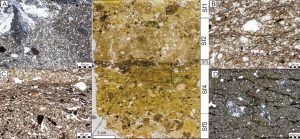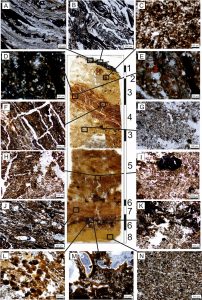06 Oct Soil micromorphology
Sedimentological analysis is important for a cognition of circumstances of origin, function, and termination of archaeological sites. A specific contextual analysis of sediments based on the microscopic study of the in-situ sediments, known as the soil micromorphology, is often necessary for a correct interpretation of archaeological record. Analysis of microstratigraphy and microstructures of archaeological layers and a research of relationships among construction features, sediments and archaeological finds is essential for the interpretation of natural deposit processes and paleoenvironmental changes as well as of cultural layers, features and manners of soil and landscape management or of a site structure.
The micromorphological analysis starts with a detailed study of a researched section directly at the site, after which soils samples are taken into special boxes. A thin section, usually 5×7 cm or 3×5 cm, is prepared from each sample. Sediment is impregnated with epoxide or more often with polyester paste and then it is cut into 0,03 mm thin sections. Each thin section is thereafter studied under petrographic, polarized light microscope.
Soil micromorphology has been for last circa fifty years respected geoarchaeological method, which was first time used in a frame of the pedologic research of buried soils. Later it was used also during a research of other types of archaeological soils and sediments, where it enabled to obtain new unique cultural and paleoenvironmental information concerning a plenty of archaeological sites.
Soil micromorphological analyses in the Excellent Research Centre of Archaeometry are conducted by Ass. Prof. Lenka Lisá, PhD. (born 1975), who belongs to the top in this field of research and who has published results of her research based on the soil micromorphology analyses from a plenty of archaeological sites in many papers in prestigious scientific journals. As an example, her study concerning a termination of ditches of the Neolithic rondels can be mentioned (Lisá et al. 2013a). Other of her papers deal for example with a topic of the origin and the development of layers at the Central European Palaeolithic sites (Lisá et al. 2013b; 2018), or with problems connected to the origin and maintenance of floors in the Medieval town houses (Lisá et al. 2020), or in the Medieval stables (Dejmal et al. 2014).
References:
Dejmal, M., Lisá, L., Nývltová Fišáková, M., Bajer, A., Petr, L., Kočár, P., Kočárová, R., Nejman, L., Rybníček, M., Sůvová, Z., Culp, R., Vavrčík, H., 2014. Medieval Horse Stable; The Results of Multi Proxy Interdisciplinary Research. Plos One, 9, 3, e89273.
Karkanas, P., Golbrg, P., 2008: Micromorphology of sediments: Deciphering archaeological context. Israel Journal of Earth Sciences, 56, 63-71.
Lisá, L., Bajer, A., Válek, D., Květina, P., Šumberová, R., 2013a: Micromorphological Evidence of Neolithic Rondel-like Ditch Infillings. Case Studies from Těšetice-Kyjovice and Kolín, Czech Republic. Interdisciplinaria Archaeologica, Natural Sciences in Archaeology, 4(2), 135-146.
Lisá, L., Škrdla, P., Havlín Nováková, H., Bajer, A., Čejchan, P., Nývltová Fišáková, M., Lisý, P., 2013b. The role of abiotic factors in ecological strategies of Gravettian hunter–gatherers within Moravia, Czech Republic. Quaternary International, 294, 71-81.
Lisá, L., Neruda, P., Nerudová, Z., Nejman, L., 2018: Podhradem Interstadial; A critical review of the middle and late MIS 3 (Denekamp, Hengelo) in Moravia, Czech Republic. Quaternary Science Reviews, 182, 191-201.
Lisá, L., Staněk, P., Zůbek, A., Nejman, L., 2020: Floor maintenance of Mediaeval buildings as a possible cultural behavioural status? Preliminary interpretations of floor formation processes from Mediaeval Brno, Czech Republic. Interdisciplinaria Archaeologica, Natural Sciences in Archaeology, 11(1).

Microscopic photo of the thin sections with particular microlayers from a floor of a Medieval house in the Veselá Street in Brno. Source: IANSA Journal XI/1/2020. Photo by L. Lisá.

Microscopic photo of the thin sections with particular microlayers from a floor of a Medieval house in the Veselá Street in Brno. Source: IANSA Journal XI/1/2020. Photo by L. Lisá.





